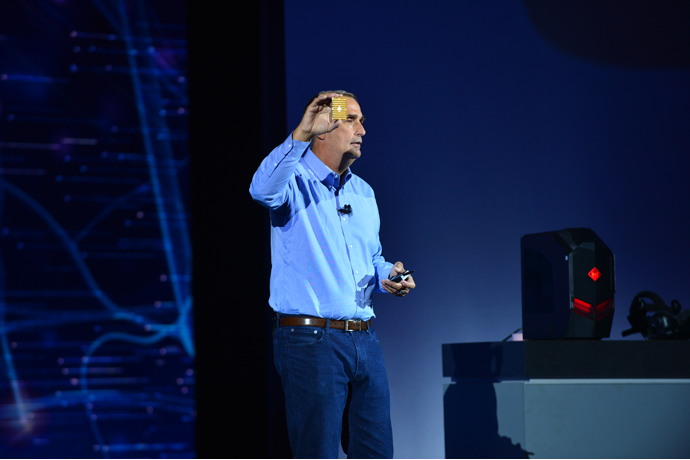
LAS VEGAS – Intel’s opening CES keynotes are usually big splashy celebrations about the future, unfortunately this time the company’s past got in the way.
2018 so far has not been a happy one for Intel. News broke on January 2 that a large portion of the world's computer processors, including Intel’s, are vulnerable to at least one of two exploits called Spectre and Meltdown that render them susceptible to hackers. The design flaw in Intel’s CPUs effects almost the entire line-up going back to 1995 and could allow malicious hackers to read sensitive data or eavesdrop on other applications running on a shared server.
Making matters worse is that in certain cases, performance on Windows will be significantly slowed by Intel’s patches for the Meltdown and Spectre vulnerabilities. It’s also been widely reported that CEO Brian Krzanich sold off about $24 million in Intel stock and options after Intel learned about the flaw, but months before it disclosed it to the public.
So when Krzanich (pictured) took to the stage yesterday at the Monte Carlo resort's Park Theater he was in full damage control mode. He began the 90-minute long keynote by promising the company would patch 90% of affected processors made in the past five years by the end of this week. After that, the following 10% of vulnerable processors will see fixes by the end of the month.
Krzanich stressed that Intel has found no evidence to suggest that either exploit has yet been used to uncover user data. Surprisingly he didn’t go on to apologize for the unprecedented vulnerabilities his company introduced into almost every computer in the world. This may be in part from the multiple class-action lawsuits regarding how its responded to this latest security threat.
Given that its chip-making rival Nvidia has just announced it is working with more than 320 partners on self-driving vehicles, including Uber and VW, Intel may have been wise to at least say it regretted the inconvenience this security threat has created for its customers.
Following the security threat update Krzanich turned to the theme of how data is the foundation of innovation.
“Data is going to introduce social and economic changes that we see perhaps once or twice in a century,” Krzanich said. “We not only find data everywhere today, but it will be the creative force behind the innovations of the future. Data is going to redefine how we experience life – in our work, in our homes, how we travel, and how we enjoy  sports and entertainment.”
sports and entertainment.”
“Immersive media” will be the next big revolution he stressed and will bring about big changes to spaces like retail, travel, medicine, film and live entertainment. He demonstrated how new technologies are helping Hollywood embrace the next generation of immersive media using volumetric video capture that maps a scene or sports field in 3D, so the viewer can watch from practically any angle they choose. It essentially produces high-end holographic content for virtual reality (VR) and augmented reality (AR).
Intel has been investing in virtual reality for the last few years and in 2016 it acquired Israeli 3D capture startup Replay Technologies. Intel now captures sports events including select NBA, NFL and PGA Tour games with 3D cameras, and streaming them to VR headsets. Krzanich added that Intel will bring VR content to the upcoming Winter Olympics through its immersive media plan and True View platform, delivering the “largest ever VR experience across 30 sports programs.”
In autonomous driving, Krzanich announced that two million vehicles from BMW, Nissan and Volkswagen will use Mobileye Road Experience Management (REM) technology to crowdsource data to build and rapidly update low-cost, scalable high-definition maps throughout this year.
He also disclosed two critical partnerships with leading automotive manufacturer SAIC Motor and digital mapping company NavInfo. In addition, SAIC will develop Level 3, 4 and 5 cars in China based on Mobileye technology.
From autonomous cars Krzanich moved on to show off a kind of autonomous flying taxi. Called the Volocopter, it’s a fully electric, vertical takeoff and landing aircraft designed for passenger transport, and it actually flew on the stage. The keynote closed with a 100 Intel Shooting Star Mini drones taking flight as part of an indoor drone light show. The stunt earned a new Guinness World Records title claims Intel for “Most UAVs airborne simultaneously from a single computer indoors.”



